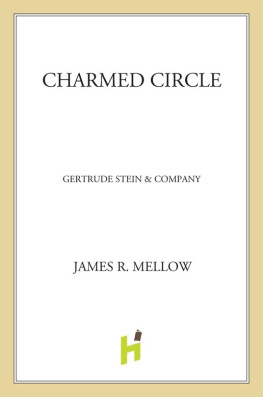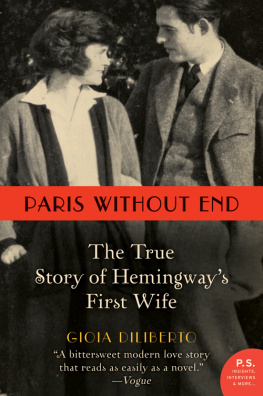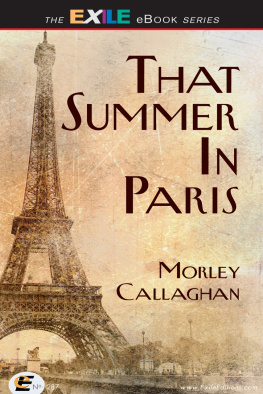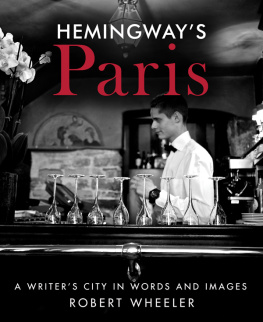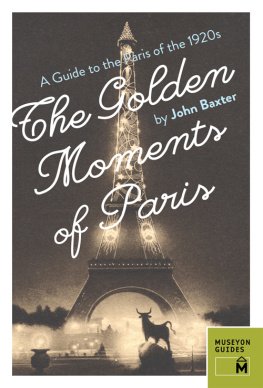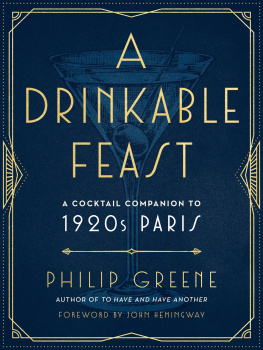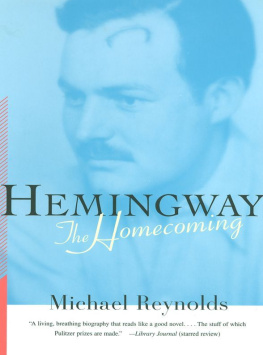John Leland - A Guide to Hemingways Paris
Here you can read online John Leland - A Guide to Hemingways Paris full text of the book (entire story) in english for free. Download pdf and epub, get meaning, cover and reviews about this ebook. year: 1989, publisher: Algonquin Books, genre: Detective and thriller. Description of the work, (preface) as well as reviews are available. Best literature library LitArk.com created for fans of good reading and offers a wide selection of genres:
Romance novel
Science fiction
Adventure
Detective
Science
History
Home and family
Prose
Art
Politics
Computer
Non-fiction
Religion
Business
Children
Humor
Choose a favorite category and find really read worthwhile books. Enjoy immersion in the world of imagination, feel the emotions of the characters or learn something new for yourself, make an fascinating discovery.

- Book:A Guide to Hemingways Paris
- Author:
- Publisher:Algonquin Books
- Genre:
- Year:1989
- Rating:3 / 5
- Favourites:Add to favourites
- Your mark:
- 60
- 1
- 2
- 3
- 4
- 5
A Guide to Hemingways Paris: summary, description and annotation
We offer to read an annotation, description, summary or preface (depends on what the author of the book "A Guide to Hemingways Paris" wrote himself). If you haven't found the necessary information about the book — write in the comments, we will try to find it.
Retracing for modern-day visitors the Paris of The Sun Also Rises and A Moveable Feast, of James Joyce, Gertrude Stein, F. Scott Fitzgerald, and Ezra Pound, thsi guidebook uncovers the cafes, hotels, restaurants, bars, nightclubs, gardens, and other landmarks immortalized by Hemingway in his fiction and nonfiction.
A Guide to Hemingways Paris — read online for free the complete book (whole text) full work
Below is the text of the book, divided by pages. System saving the place of the last page read, allows you to conveniently read the book "A Guide to Hemingways Paris" online for free, without having to search again every time where you left off. Put a bookmark, and you can go to the page where you finished reading at any time.
Font size:
Interval:
Bookmark:
A GUIDE TO
HEMINGWAYS PARIS
BY JOHN LELAND
With a Foreword by
LOUIS D. RUBIN, JR.

Algonquin Books of Chapel Hill
1992

Hemingway with Sylvia Beach, at Shakespeare and Company. (Princeton University Library, Sylvia Beach Collection)
Published by
Algonquin Books of Chapel Hill
Post Office Box 2225
Chapel Hill, North Carolina 27515-2225
a division of
Workman Publishing Company, Inc.
708 Broadway
New York, New York 10003
1989 by John Leland. All rights reserved.
Library of Congress Cataloging-in-Publication Data available upon request.
Frontispiece photograph: Hemingway with Sylvia Beach, owner of Shakespeare and Company, on her birthday, 1928. Bandage is from Hemingways 2:00 A.M. encounter with a skylight in the bathroom of a caf. The inscription reads: To Sylvia with love, farewell to face wounds (from any source!), Ernest Hemingway. (Princeton University Library, Sylvia Beach Collection)
For Bee and Isabella
Louis D. Rubin, Jr.
It is no secret that we tend to see our world through the eyes of the artists who have revealed it to us. We observe an especially gaudy and pinkish, cloud-strewn evening sky and say immediately that it is a Maxfield Parrish sunset. We view a place or remember a time, and respond in terms of its depiction in literary work. Once my friend Lewis Simpson and I were driving to Greenville, Mississippi, when we came to a bridge over the Yazoo River at Greenwood, with a sign on it reading, Bridge Being Painted. Stop on Other Side to Have Paint Spots Removed from Your Car. Of course we thought immediately of Eudora Welty, who had taught us in her fiction how to interpret that experience.
Could any visitor familiar with James Joyces fiction walk through downtown Dublin, Ireland, and not see Leopold Blooms world? Composition of place. Ignatius Loyola, make haste to help me, Stephen Dedalus thinks to himself as he hones his argument in the National Library chapter of Ulysses. How well Joyce managed is involuntarily corroborated by the indignant response of the librarian Richard Best when asked to take part in a radio documentary on Joyces life. After all, youre a character in Ulysses, a BBC representative insisted.
I am not, declared Best. I am a living being.
Surely it is not among the lesser literary accomplishments of Ernest Miller Hemingway that for what is now more than a half-century he has been actively instructing generations of readers in how to visit and enjoy Paris, France. Since 1926, when Jake Barnes, in The Sun Also Rises, set out for the Caf Napolitain to have an aperitif with Robert Cohn and watch the evening crowd, Hemingways Paris has been ours as well. For English-language readers at least, his interpretation of the capital city of France takes precedence over Henry Jamess, Stendhals, even Marcel Prousts.
Perhaps this is because he was only and always a visitor there, and gave us, exclusively and passionately, an outsiders view. As Mr. Leland points out in the preface to this guidebook, the only native Frenchman who figures in The Sun Also Rises is the prostitute Georgette Hobin, and her role is distinctly minor. All the other characters, whether American, English, or whatever, are outlanders and therefore outsiders. To be one of us, as Brett Ashley says of Count Mippipopulous, is to be a dweller in a foreign place who cannot and does not wish to return home, and yet is not at home in the foreign place, either. Rather, what makes him one of us is that he knows, whether philosophically or by instinct, that there can be no home, in the sense of a place where one can feel civic and emotional allegiance to a rational community. To dwell in Paris, therefore, is to inhabit by choice and conviction a stage setting, clean and well-lighted, in which the senses may be indulged and the attention diverted and kept amused. It is also desirable that one not speak the language well enough to think in it, since in order to remain there and enjoy doing so one must stay uncommitted and uninvolved, and be able to not think about it.
For whatever reason, the way that Hemingway saw and described Paris in the 1920s has afforded that city a particular kind of glamour, a special aura of attraction, that has sent many a literary young American in search of it. It was Hemingways Paris that the still-young veterans of World War II went looking for in the late 1940s and early 1950s. And for all the critical talk about the decline of Hemingways reputation, it draws them stillas the very existence of this useful guidebook demonstrates.
Hemingway was the ideal chronicler of the delights of post-1918 Paris, for a number of reasons. For one, no more skilled interpreter of sensuous experience ever lived or wrote. The Hemingway style that strove to get down to what was elemental, the literary artistry that was designed to cut through what he considered was the massively coated veneer of cerebral abstraction and to restore what was physical and real, could describe colors and re-create tastes and tactile sensation in unforgettable ways. I defy anyone, for example, to read the account, in The Sun Also Rises, of Jake Barnes and Bill Gorton opening and drinking a bottle of wine after a morning of trout-fishing in the Pyrnes, without feeling thirsty. If it proved to have its limitations, as it did in the 1930s and 1940s, the Hemingway way with language was unsurpassed at what it was designed to do.
But there was, and is, more to it than sensuousness. The style, the concentration on what could be seen and felt, was not only a method of description, but a philosophical assertion in its own right, a way of confronting ones experience. You are all a lost generation, Gertrude Stein is quoted as saying as prelude to The Sun Also Rises. And although Hemingway later insisted that the use of that remark as epigraph, and the novels title and the passage from Ecclesiastes as well, were meant to be taken ironically, both the author and his readers knew that it was more complicated than that. The sensuous language, the evocation of the look and feel of Paris and the joys of wine cellar and cuisine and spectacle and casual pleasuring, were artfully shaped as a way of keeping the post-Versailles world at bay, of insisting that the only tenable approach to experience was to withhold ones participation beyond the sensuous level. The characters who inhabit The Sun Also Rises are resolute in their determination to deny any involvement in a world they did not make and cannot understandeither that or, like Robert Cohn, they are not allowed to remain members in good standing.
I stress the word determination, for that is what it is: not a fact, but an urgent insistence. As they stroll along the boulevards, find seats in the cafs, or otherwise position themselves to take in the Parisian scene, they strive to focus their attention upon what is exterior and outside of them, in order to keep from remembering what they cannot make sense of or do anything about. The sensuous charms of Hemingways Paris draw considerable allure from the pathos through which they are perceived, a pathos born of youthful disappointment and blighted hopes. The attractions of the City of Light, in short, gain in their intensity because so much of what they represent is privileged indulgence: the delights of sensory experience, with the participants at least temporarily exempted from puritanical guilt because that indulgence is prefaced by an assertion of futility, and made bittersweet in retrospect by the Preachers reminder that the wind goeth toward the south, and turneth about unto the north; it whirleth about continually What it is is neo-Byronic Romanticism. Lambert Strether would have understood very well; so would Henri Beyle.
Next pageFont size:
Interval:
Bookmark:
Similar books «A Guide to Hemingways Paris»
Look at similar books to A Guide to Hemingways Paris. We have selected literature similar in name and meaning in the hope of providing readers with more options to find new, interesting, not yet read works.
Discussion, reviews of the book A Guide to Hemingways Paris and just readers' own opinions. Leave your comments, write what you think about the work, its meaning or the main characters. Specify what exactly you liked and what you didn't like, and why you think so.



